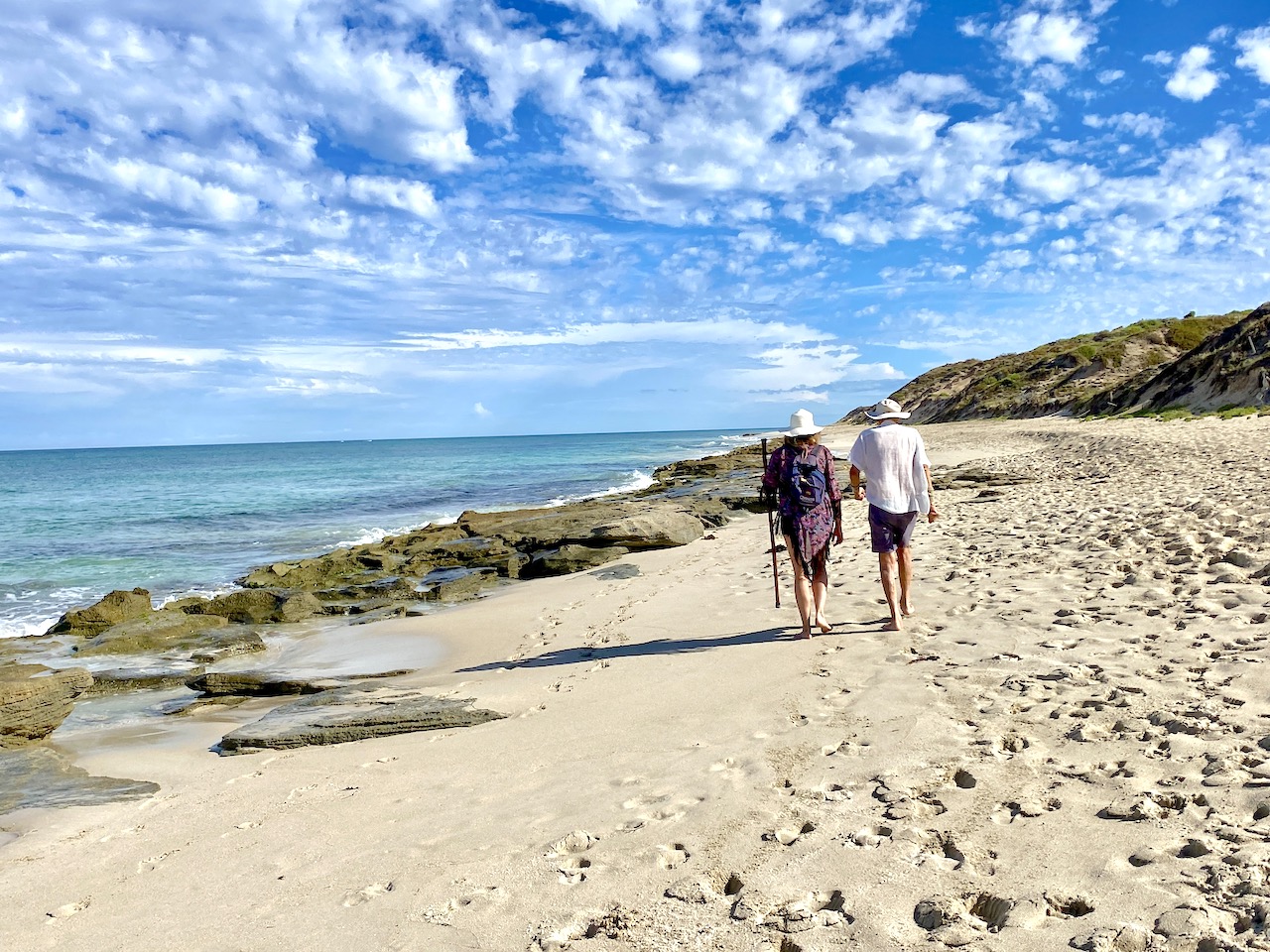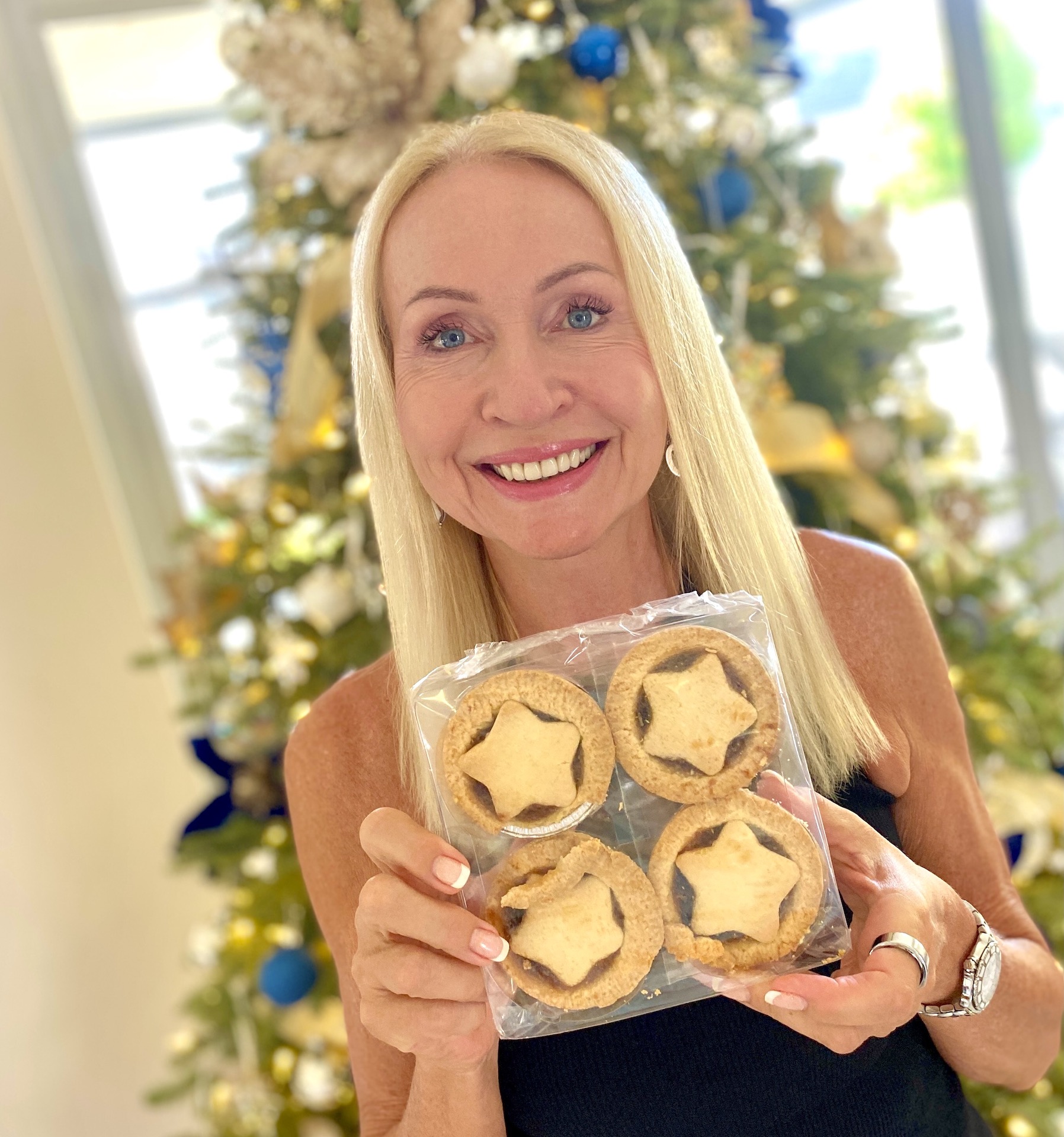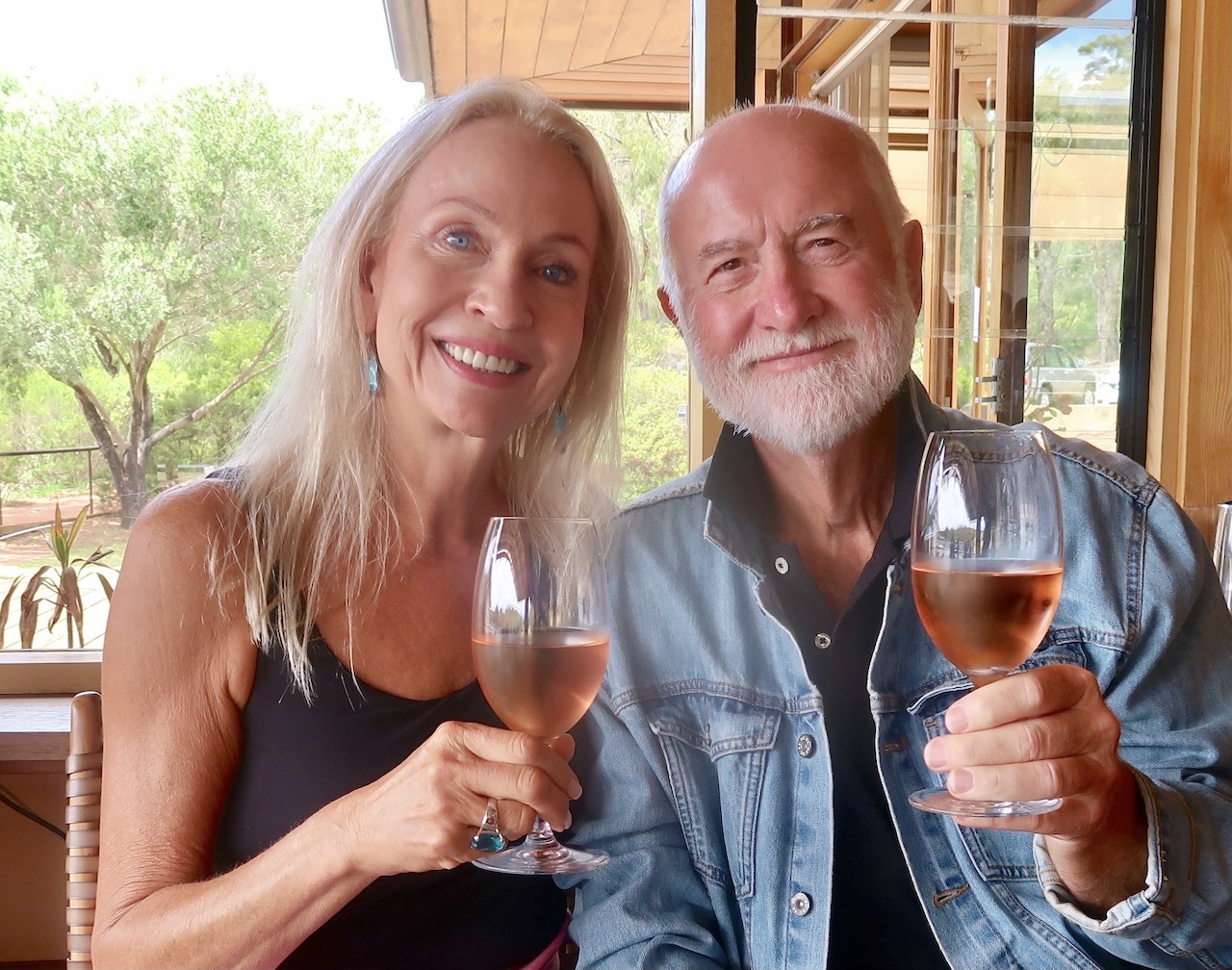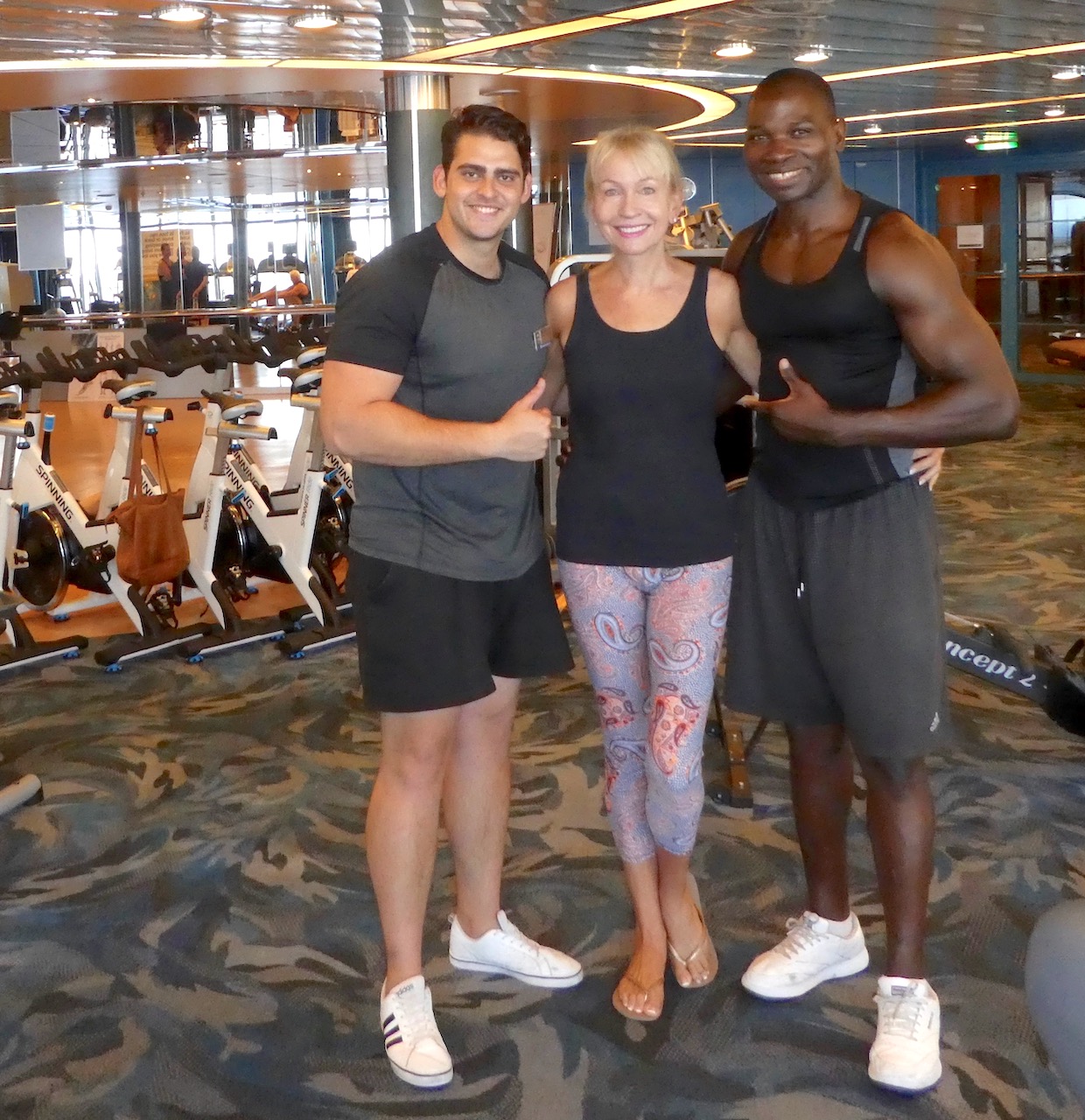Our light diet may be as important as sleep, nutrition and exercise, VERNE MAREE discovers.
I rejoice when I see Roy outside with his shirt off. Not only because he – like most of us – looks heaps better with a tan, but because I know it’s boosting his immune system and helping him to live long and strong.
In fact, he’s just had a load of blood tests – and his Vitamin D is way up where it belongs.

(The above pic of Roy on Yallingup Beach was taken a couple of weeks ago; click here for that travel blog post, and if you like it, please sign up to Travels with Verne and Roy!)
Dem Bones and Your Light Diet
My Vitamin D level is good, too. And it’s been that way for a long time, at least since I was diagnosed with osteoporosis (thinning bones) some 14 or 15 years ago and my wonderful integrative GP in Singapore, Dr Ian Lee, got me started on testing it regularly. Together with various other nutrients (Vitamin K2 in particular), Vitamin D3 is vital for making strong bones. (Because we’re animals, it absolutely has to be the animal form, D3, and not the D2 plant form.)

If you were kindly wondering how my bones are doing nowadays, thanks for asking! The answer is: pretty good, thank you. Keeping my levels up, taking a compounded Vitamin D plus Vitamin K2 supplement and doing high-impact exercise like jogging and sprinting seem to be doing the trick: according to my annual DEXA scans, I haven’t lost any more bone density. (For more on preventing and reversing bone loss, go to saveourbones.com.)
However, I’ve only just learnt something new about Vitamin K2 supplementation that I heartily wish I’d known a couple of years ago. In short, I should be taking far, far more of the stuff. (According to holistic dentist educator Dr Judsen Wall, from 5 to 25 grams is the therapeutic dose, not the 225 micrograms that I was prescribed and have been taking for two or three years! I plan to blog more about healthy bones and teeth in a future post; for now, you can listen to him here on Ari Whitten’s outstanding podcast show, The Energy Blueprint.)
Moving on. Now that we’re well into autumn, I revel in the certainty of a West Australian winter where seasonal rains are reliably punctuated with plenty of healthy, radiant sunshine. It’s a true blessing.

Fun Facts: Vitamin D
Let’s consider a few fun facts about the so-called Sunshine Vitamin.
#1 Here’s one especially for anyone who still thinks statins are a good idea. Cholesterol is a precursor to Vitamin D – so cholesterol-lowering drugs also reduce the body’s ability to synthesise Vitamin D. (Chris Masterjohn PhD quoted in the British Medical Journal.) And for anyone who still believes the now-discredited heart-health hypothesis – that dietary fat, particularly cholesterol, causes heart disease – click here to take a look at Living Long and Strong with Verne and Roy #11, titled How Much Fat do We Need to Eat?
#2 Sunlight is necessary to turn the cholesterol on your skin into Vitamin D, so it follows that avoiding the sun reduces your ability to make Vitamin D.
#3 Vitamin D-rich foods such as most fish (especially salmon, tuna, sardines, herring etc.), meat, liver, eggs and butter are also rich in cholesterol, so low-cholesterol diets are inherently deficient in Vitamin D.

#4 Vitamin D deficiency is strongly related with compromised immunity in general and COVID-19 hospitalisation and death in particular. See here for more. (I respectfully submit that this is indeed a fun fact – though perhaps only for those with optimal levels.)
Getting Enough, Sunshine?
Everyone knows by now about the sunshine and Vitamin D connection. And that most people don’t get enough of the former to make enough of the latter.
Unfortunately, you really can’t get enough Vitamin D from food. Seafood is the only significant source, says functional medicine guru Chris Kresser; and you would need around 300g of herring to deliver your daily dose. Unless you’re a seal, that’s a lot of herring.


The best way to get it is as Nature intended and evolution ordained – from regular, full-body exposure to sunlight. I know how lucky I am, and that few people have both the luxury of enough free time and access to the right climate to be able to bask outdoors most months of the year.

How will you know if your own Vitamin D levels are optimal? Only by testing them.
Test, Don’t Guess!
It’s not just a matter of getting a blood test, though that’s a good place to start. Any doctor will authorise it, and it’s one of the least expensive tests. (Tip: Don’t be satisfied with a level that’s normal, adequate or sufficient. You want optimal.)
Individual requirements for Vitamin D can be very different, and for different reasons. According to the report I got from Sharon Palmer at iDNA Perth, back in 2018, I have genetic mutations on most of the seven pathways required for the proper synthesis and use of Vitamin D in my body.
That report was based on the 23andme genetic testing I did through her – and from which she’s been able to provide me with personalised reports on various aspects of my genetic health profile. Here’s a link to my personalised Vit D Pathway Report, so you can see exactly how detailed and useful the information is. (Sharon does remote consultations, too, and I highly recommend her for her impeccable knowledge and thoroughness.)
Basically, I am genetically predisposed to low levels of Vitamin D, so I have to work especially hard to keep my numbers as high as I can – even way above what’s regarded as optimal. That’s because sufficient or high serum (blood) levels of Vitamin D don’t necessarily mean it’s available for uptake into your cells.
What is more, the older we get, the less able we are to make and use Vitamin D. You can be 65 years old, brown as a berry, and yet dangerously deficient in Vitamin D.
Fortunately, there’s always supplementation – and almost universal agreement that this is essential for most of us. Recommended supplemental dosages range from as little as 400iu to 10,000iu or more per day, depending on your unique biological requirements. For the record, Roy takes 1,000iu; I take 5,000iu. (Remember, you must take Vitamin K2 with it: they work as a team, as explained here.)
Annoyingly, most websites detailing “The 10 Best Food Sources of Vitamin D” – or five, six or whatever – feature highly processed, low-nutrition carbage* like breakfast cereals and orange juice, and crappy hydrogenated seed-oils like margarine. I’ve just had a horrible flashback to a South African margarine called Sunshine D. What a travesty – I thank my clever dad for refusing to have it in the house.
- Great word that! I heard it first from Jimmy Moore’s podcast Livin’ La Vida Lowcarb; he may even have coined it.
Assessing Your Light Diet
Tony, one of my local beach friends, tried to warn me against the sun the other day. Skin cancer, you know. He did it with apparent casualness, but I suspected he was genuinely concerned and had been building up to it for some time.

The main problem with public warnings against sun exposure is that they come from a misguided medical industry that divides the body into supposedly different systems and treats it according to specious specialties. Dermatologists concentrate only on skin ailments. Cardiologists on what goes wrong with the heart, urologists with the mysteries of our plumbing, opthalmologists with our eyes, dentists with our teeth, and so on. One small problem: that’s just not how the body works.
Back to those damned dermatologists for a minute. In between Botox injections, many dermatologists deal all day with skin cancers that are generally associated with over-exposure to UV light. So hey ho, UV light is pathological, no question about it.
Never mind the fact that we humans evolved under the sun and therefore require light for survival, and plenty of it for vibrant good health. In fact, the right amount of sunlight is positively protective, even against melanoma!

At Expat Living Singapore, I worked with a wonderful Aussie editor whom I much admired. We almost never clashed (probably because he was so polite), except for one day – and it was when I remarked that children Down Under weren’t getting enough sun exposure. I was referring to my own pale grandchildren, but we’d all had a couple of beers, and he seemed to take it personally. The habitually urbane Brisbanite was perceptibly peeved. Clearly, I didn’t know what I was talking about. “Australian sunshine is different!” he snapped.
Aussie sunshine is strong, and we get a lot of it; but it’s not intrinsically different to the sun in South Africa, Singapore, India or California. It’s to do with education, and it’s a matter of management. A decade or two of “Slip, Slop, Slap” propaganda – slip on a shirt, slop on the SP50 and slap on a hat – has swung the pendulum too far, and now the preposterous reality is that Aussies are suffering from illnesses related to Vitamin D deficiencies.
These include not only rickets in children and osteoporosis in adults, according to one of many studies, but also cancers, cardiovascular disease, autoimmune disease, depression and more.

Unlike mad dogs and Englishmen, I don’t venture under the sun without what I consider reasonable protection. Vulnerable areas like face, neck and chest get a layer of Cetaphil Daily Moisturiser SPF 15, which I’ve been using for a good dozen or more years. This one is not available in Australia, except online. Cetaphil Daily Moisturiser SPF 30 is available here, but I find it sticky and cloying. What’s more, I’m persuaded that any SPF higher than 15 offers very little more protection, while delivering unnecessarily more chemical toxicity.

Actually, I’m looking for a better product that’s zinc-based, and therefore more of a physical block than a chemical one – so I’d be grateful for any recommended alternative that doesn’t give the face a deathly sheen and also works well under makeup. Sukin, which is of course a far healthier brand than Cetaphil, does a tinted SPF 20 that’s not bad, apart from being too greasy to use under makeup.
Amazing Red Light
If you didn’t already know this, prepare to be amazed. Almost incredibly, exposure to early morning light, specifically red and infrared, is critical for enhancing and strengthening the skin: it prepares your skin for a day in the sun and protects it against burning. This is what would happen if you watched the sun rise each morning. (Explained more here; research here.)
Alas, I don’t get to bed in time to be up for the sunrise. So, one of the other ways I protect my skin against sun damage is with about 30 minutes’ exposure each morning to my PlatinumLED red and near-infrared lamp. Roy does it too, usually straight after me. (Now you know the secret of his pearlescent complexion and radiant glow.)
Hung behind our bathroom door, its LED lights beam through the shutters and cast a weird reflection across the street on to our neighbours’ living room window. Carrie had to explain to them what was going on… No, her mother-in-law hadn’t decided to hang out a shingle.

I’ve barely scratched the surface of what light does for us, but enough already. Up next will be how getting the bright morning light in my eyes sets me up for a good night’s sleep. And how too much blue light can make us fat… yes, really!





Verne
I am Very Impressed with your articles.
Certainly with your enquiring mind and application you have hit the nail on the head.
No question we need cholesterol, we need sunlight’s version of Vitamin D. I have experienced that in my entire life – when taking blood tests I have always been ok. But suddenly the other day on a checkup, my Vitamin D was way down. Not surprising, as I do all my running between 3 and 7 am.
We always had a saying that the safest time to run in the sun was when your shadow was longer than your height. But to not be in the sun more than a few minutes per day in my present situation has caused my deficiency. So my change of schedule now is to delay breakfast for two days per week and run up to 10am. Naturally, I am now taking tablets for a while to re-establish the balance.
I ran a Comrades marathon qualifier yesterday, and was on schedule to 25km when the wheels fell off; I finished but did not qualify. I have one more chance in July, which I will accomplish.
I had cramps yesterday in muscles I never knew I had. Got home and walked quite a bit. But in the evening, while sitting, I was cramping, and when in bed again two to three times. I had taken a slow Mag capsule twice during the race. Last night in desperation after having another slow Mag, with little relief, I assumed I had built up too much acidity in the blood, from tissue breakdown. So I drank a glass of water with a teaspoon of bicarb; not a single problem thereafter, and absolutely no stiffness this morning.
I did this because I remembered that, way back in the Dark Ages, we used to prepare our drinks for the seconds to give to us during Comrades runs. The contents were a half-teaspoon of bicarbonate of soda, a pinch of salt, orange juice, lemonade and a half-tot of brandy. (It was known as the “corpse reviver”. Prof Tim Noakes then took that and modified it into the commercial drink sold as Energade.)
I was also becoming dizzy on the downhills, when trying to get back on pace. I was told that my blood pressure was dropping and the body was trying to get my head down to increase blood to the head. (Maybe my circulation is just not strong enough anymore; I do not know.)
Seeing your research and the absolute detail that you have shown with your various subjects discussed, and that you are still an active runner etc, I thought there is no one that would dig into this better than you.
I enjoy seeing your and Roy’s absolute “loving life” attitude and wondered what your thoughts would be. I have got to qualify, my goal is to be the oldest man ever by 3 years to complete the Comrades, due on the 25th August. I have entered.
Lots of love, miss you guys, all the best,
Alf
Dear Alf,
It’s a delight to read your comments, and thanks for the vote of approval! I often think back fondly on the running group that you led, and your inspirational coaching. The bicarb tip is so interesting – I hear it on many alternative health forums. Let’s chat soon.